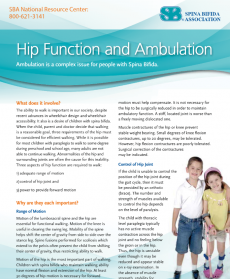Three aspects of hip function are required to walk: 1) adequate range of motion 2) control of hip joint and 3) power to provide forward motion
Why are they each important?
Range of Motion
The motion of the hip is the most important part of walking. Children with Spina Bifida who maintain walking ability have normal joint movement and extension of the hip. At least 30 degrees of hip motion is necessary for forward progression. With less than 30 degrees, the pelvic motion must help compensate. It is not necessary for the hip to be surgically reduced in order to maintain ambulatory function.
It is not necessary for the hip to be surgically reduced in order to maintain ambulatory function. A stiff, located joint is worse than a freely moving dislocated one. Muscle contractures of the hip or knee prevent stable weight bearing. Small degrees of knee flexion contractures, up to 20 degrees, may be tolerated. However, hip flexion contractures are poorly tolerated. Surgical correction of the contractures may be indicated.
Control of Hip Joint
If the child is unable to control the position of the hip joint while walking (gait cycle), then it must be provided by an orthotic (brace). The number and strength of muscles available to control the hip depends on the level of paralysis. The child with thoracic-level paraplegia typically has no active muscle contraction across the hip joint and no feeling below the groin or in the hip. Thus, the hip is unstable even though it may be reduced and appear stable on X-ray examination.
In the absence of muscle strength, stability for walking can only be provided by an orthosis that crosses the hip joint. The orthosis must have a lockable hip joint and transmit the floor reaction force high enough onto the trunk of the child to provide sensory information about the forces happening at floor level. If the brace does not have built-in motion, the child can only walk with a hopping type of gait. Orthotic systems have been developed to make walking more efficient by providing controlled flexion and extension of the hip joint.
The child with upper lumbar paraplegia has several muscles crossing the hip joint including the hip flexors and the hip adductors, which bring the legs together. The muscles that spread the leg and extend the leg are absent. Some sensation crossing the hip joint is present. During standing, the hip flexors and hip adductors contract to maintain stability of the hip, causing the child to pitch forward. To keep from falling, most of the child’s weight is transferred through their arms to crutches or a walker. This is not a functional posture for walking. There is no way of surgically providing stability to this hip and, similar to the child with thoracic-level paraplegia, hip stability must be provided by an orthosis.
The child with upper lumbar paraplegia has several muscles crossing the hip joint including the hip flexors and the hip adductors, which bring the legs together. The muscles that spread the leg and extend the leg are absent. Some sensation crossing the hip joint is present. During standing, the hip flexors and hip adductors contract to maintain stability of the hip, causing the child to pitch forward. In order to keep from falling, most of the child’s weight is transferred through their arms to crutches or a walker. This is not a functional posture for walking. There is no way of surgically providing stability to this hip and, similar to the child with thoracic-level paraplegia, hip stability must be provided by an orthosis.
The reciprocating gait orthosis or hip guidance orthosis provides even greater benefit for children with upper lumbar paraplegia due to presence of some sensation across the hip joint.
The child with mid and lower lumbar paraplegia has active hip flexor, hip adductor and knee extensor muscles. Knee extensor muscles are present but weak. Hip extensors and hip abductors muscles that move the legs apart are absent, but are the most important muscles for standing and walking. The hamstring muscles, although weak, will extend the hip and allow children with mid and lower lumbar paraplegia to walk without orthotic control of the hip. Knee flexion contractures may result, and the imbalance of muscle forces around the hip may lead to hip dislocation. Hip surgery to improve hip function can be performed for people who meet the criteria.
The child with sacral level paraplegia has sufficient muscle control around the hip to provide the necessary stability, and they rarely need hip surgery.
Power to Provide Forward Motion
The force to move forward requires more than muscle contraction to control the hip joints. In most individuals, the calf muscles provide the force that pushes the leg and body forward to take the next step. The hip extensors pull the body forward after the foot hits the floor. The calf and hip extensors have sacral level nerve innervations and are paralyzed in almost all children who have Spina Bifida.
Children with thoracic and upper lumbar level paraplegia use their arms and crutches or walker to create the power to move forward. The arms are inefficient and not designed for this activity; therefore, walking is slower and takes more effort. Children with mid and lower lumbar level paraplegia shift their trunk from side to side in an attempt to produce forward motion; however, this too
requires extra energy.
Some individuals with Spina Bifida discover wheelchairs are a more efficient means of travel when they become adults.
This information does not constitute medical advice for any individual. As specific cases may vary from the general information presented here, SBA advises readers to consult a quailed medical or other professional on an individual basis.



